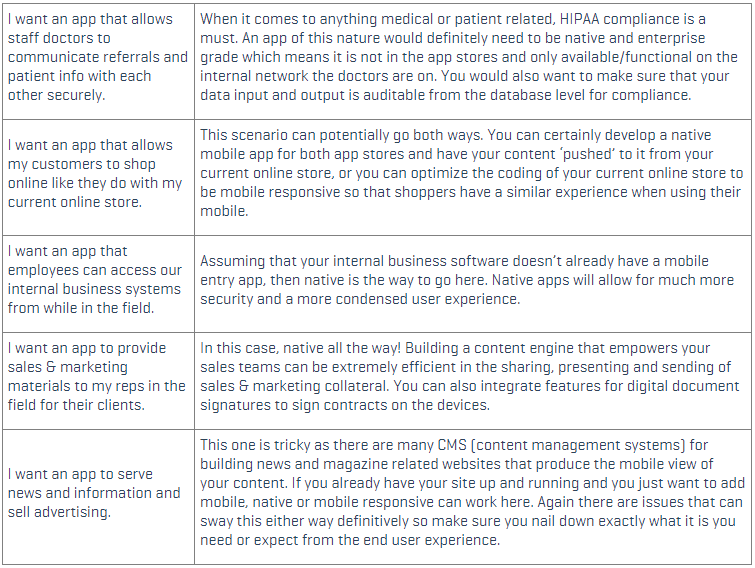Why Does My Business Need a Mobile App?
What is the Mobile Experience all About?
Five years ago, mobile was really a class unto itself. Today, the lines between mobile and desktop are extremely blurred and on a future collision course when everything is just content and it is all consumed from whatever device the consumer wants to use. On top of this, there is a distinct difference between a native mobile app and a responsive website that looks mobile. Confused? A lot of businesses are, too. The true definition of the mobile experience is that “you can deliver your content/message from a central point to any internet connected device for consumption.” The biggest issue is knowing when a mobile responsive website is enough versus when you need the specialized experience of a true native mobile app.
Native Mobile versus Mobile Responsive
Put simply, a native app is one that is coded and designed to work within the parameters of the two major mobile app stores – Apple/iOS and Google Play/Android. The creation of a single mobile app can result in the catering of said app to two totally different sets of device users. This brings the advantage of accessing the largest possible market of device users (into the billions worldwide). A mobile responsive app is simply a website or web application serving content that when viewed on a mobile device, the content will conform to the screen it is being displayed on. No extra coding needed, but a different experience than downloading and using a native mobile app.
Pros and Cons of Native versus Responsive
A recent article from Business Computing World UK by blogger Chrissy Ma provides wonderful insight into this area.
- Programming language – Though most mobile platforms release their own SDKs, enabling developers to build apps in the platforms’ supported programming language, these languages generally belong to one of a few root languages. For instance, C# is supported natively by Windows 8 platform whereas C and C++ can be used in BlackBerry, Windows and Android mobile apps.
- UX and UI – One of the biggest difficulties the cross platform development approach needs to tackle is the implementation of the different user interface and user experience patterns unique to the individual platform. While creating a uniform design pattern compatible with all platforms, design principles and design philosophies should, on no account, be ignored. A typical example is the app design for Windows Phone. Whilst most platforms strive for an app design that looks and feels like a counterpart of them in the real world, the Windows Phone apps seek for imposing authentic digital experience as much as possible. Another major challenge in uniform design is that the UI design may look completely different across each platform. Sometimes, the development team will use the tactic mimicking UI elements that look but do not work the same on each platform. But once users switch devices owning the different operating system, they will be probably suffering inconsistent user experience. Therefore, rather than spending much effort mimicking a native control, it is comparatively easier to create an elegant design on a single platform which makes the app becomes very intuitive.
- Multitasking support – Multitasking makes it possible to run some apps at the same time. This feature may behave differently across each platform. Taking Android as an example. There are a few background services and you can run a couple of apps at the same time. Users do not have to exit apps as it will be done by the OS automatically when resources run low whereas, on iPhone, users always need to double click “Home” button and swipe up the windows in order to totally stop running the app. Otherwise, with a limited selection of background tasks, those iOS apps will continue to do tasks even if users exit apps. If background services could help improve app offerings, it is highly recommended to evaluate cross platform strategies carefully to ensure that it gains full access to the capabilities of mobile phones.
- In-app activities – In-app purchase, in-app advertisements and in-app push services are considered as three principal aspects whilst evaluating payment features of a platform. Moreover, the former two factors play an essential role from mobile app monetization perspective, particularly, in terms of game apps monetization. For instance, the in-app advertisement mechanism works differently on each platform and there are some independent third-party vendors providing platform-specific payment solutions. Considering the security and convenience of the transaction process within the app, these in-app activities definitely add value to a better user experience and higher revenue.
Signs that Your Business is Ready for a Mobile Experience
So when you think it’s time for mobile, how do you know which direction to take? Here are some tips to consider:

Are You Prepared?
Envoc stands ready with cutting edge talent and innovative thinking to plan and implement a mobile strategy that best suits your needs for today and tomorrow.






